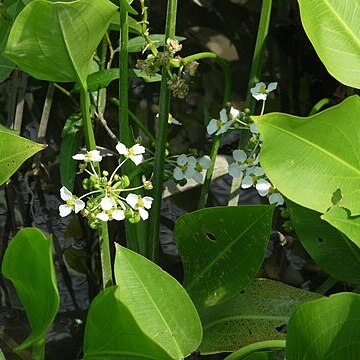Perennial, glabrous, with subterranean stolons. Emerged leaves erect, narrow-elliptic to lanceolate, acute, gradually narrowed towards the base, 5.5-10 by 1-3 cm; in extra-Mal. specim. also phyllodes; nerves 5-7, arising at the leaf-base, prominent on the undersurface, connected by parallel cross-veins spaced c. 1 mm under an angle of c. 45°; petiole sharply triangular, narrowly winged, ribbed, with air-channels, 25-40 cm in sicco with distinct septations c. 5-7 mm spaced; sheath broad. Peduncles erect, very bluntly triangular, with air-channels, incl. the raceme 30-40 cm. Raceme about 1/4 as long as the peduncle, with 4-6 whorls of 3 flowers, the lower 2 whorls female, the others male. Bracts connate, broad-ovate to suborbicular, obtuse, margin scarious, c. 3-4 mm. Pedicels 8-20 mm, obliquely erect, fruiting pedicels recurved and strongly thickened. Flowers c. 2 cm diam. Sepals blunt elliptic, broadly scarious-margined, recurved after anthesis, 4-4½ mm long. Petals white, transverse elliptic, short-unguiculate, slightly sinuate at the apex, 10 by 13 mm. Stamens 12-18; filaments c. 1 mm, strongly dilated, flattened, slightly hairy; anthers oblong, 0.8-1 mm. Carpels ∞, obliquely elliptic, 1 mm; style apical though ventrally inserted, sometimes curved; stigma punctiform. Fruiting heads globular, 8-10 mm. Achenes obovate, 2 by 1 mm, dorsally and ventrally winged, with 2 additional dorso-lateral ribs, slightly compressed; beak 1/3 mm, apical, obliquely erected inward. Seed pale brown.
More
Herbs, perennial, to 150 cm; rhizomes absent; stolons present; corms present. Leaves submersed and emersed; submersed sessile, phyllodial, flattened, to 26 ´ 0.5 cm; emersed with petiole ± triangular, 21--70.5 cm, blade linear-ovate to ovate, 4.6--16.4 ´ 0.7--6.1 cm. Inflorescences racemes, of 3--9 whorls, emersed, 2.5--10 ´ 2--4.5 cm; peduncles 22--60 cm; bracts connate more than ¼ total length, lanceolate, 3--5.5 mm, delicate, not papillose; fruiting pedicels spreading to recurved, cylindric, 0.5--3 cm. Flowers to 1.8 cm diam.; sepals spreading to recurved, not enclosing flower or fruiting head; filaments dilated, longer than anthers, pubescent; pistillate pedicellate, without ring of sterile stamens. Fruiting heads 0.7--1.2 cm diam.; achenes oblanceoloid, not abaxially keeled, 1.2--2 ´ 0.8--1.2 mm, beaked; faces tuberculate, wings absent, glands absent; beak lateral, horizontal to erect, 0.3--0.6 mm. 2n = 22.
Emergent aquatic, rhizomatous, perennial; root tubers commonly formed, to 4 cm long and 1.5 cm wide. Juvenile leaves submerged, to 50 cm long and 2 cm wide, with no obvious blade development. Mature leaves with emergent blade; blade linear or ovate, rarely cordate, to 25 cm long and 10 cm wide. Inflorescence to 30 cm long, with 4–numerous whorls; bracts fused near base, with lower bracts 3–5 mm long becoming shorter upwards; lower 1–6 whorls female, upper male. Flowers c. 3 cm diam.; sepals 3–8 mm long; petals about twice sepal length, white. Male flowers with 12–numerous stamens; filaments dilated, pubescent. Female flowers with numerous carpels. Fruiting flowers 1–2 cm diam., with pedicels thickened and recurved or reflexed. Achenes with broad wings, 1.2–3 mm long.
In wet rice-fields, between Djakarta and Bogor, up to 250 m, found for the first time by J. H. KERN Trop. Natuur 32 1952 127 cum fig. in 1950; almost certainly escaped from plants formerly cultivated in the Botanic Gardens, Bogor.
More
Grows in shallow, permanent, static or slow-moving freshwater, on stream banks and periodically inundated areas such as drains and channels; can be a weed of rice-growing areas.

